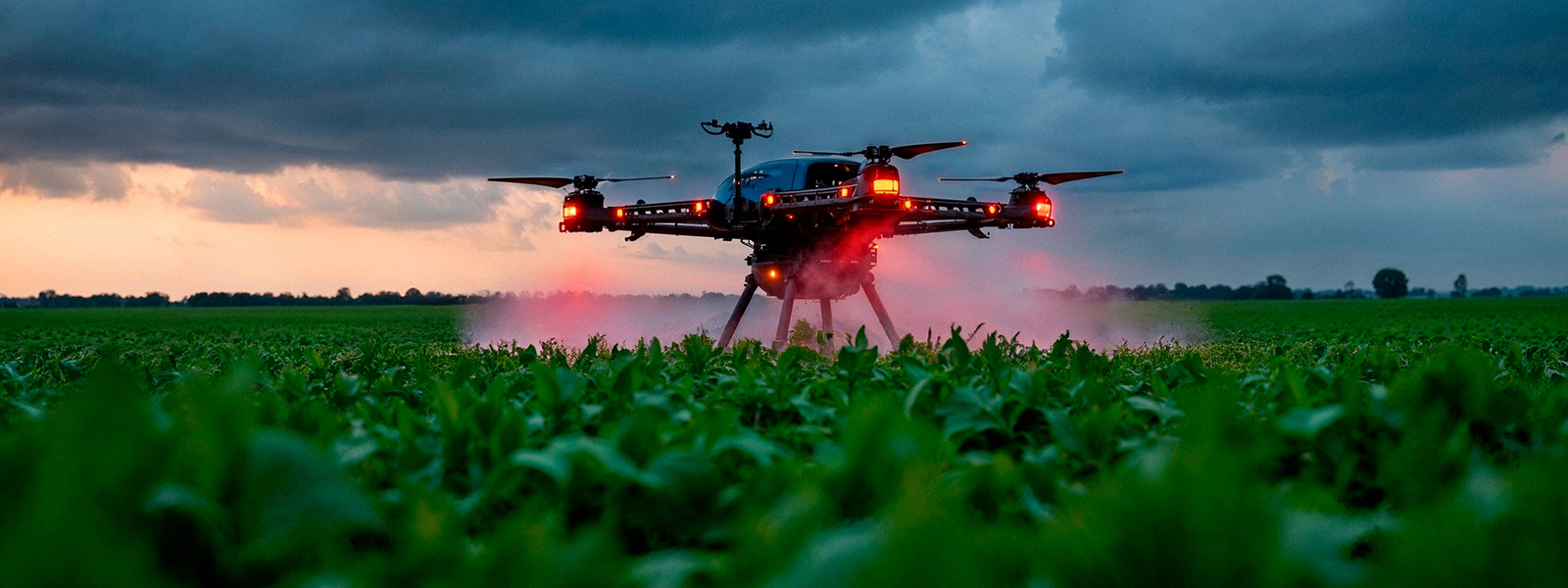AGP China Technology Report - Agricultural Robots
Table of Contents
Page Section
03 Technology Overview
06 Historical Development Timeline
08 Product Differentiation
15 China Technology Ecosystem
17 Sino-Foreign Collaboration
19 Common Applications In China
26 Government Policy Support
29 Impact On Market Incumbents
30 Final Conclusion
31 Appendices
1.1 Global Snapshot
Definition and Classification
Agricultural robots, or agri-bots, are autonomous or semi-autonomous machines designed to perform various farming tasks, enhancing efficiency and productivity. These robots are categorized based on their functions:
- Driverless Tractors: Automated vehicles for plowing, planting, and harvesting.
- Unmanned Aerial Vehicles (UAVs): Drones used for crop monitoring, spraying, and mapping.
- Milking Robots: Systems that automate the milking process in dairy farming.
- Automated Harvest Robots: Machines designed to pick fruits and vegetables.
Key Technologies
The functionality of agricultural robots relies on several core technologies:
- Sensors: Utilized for environmental monitoring, obstacle detection, and crop assessment.
- Actuators: Enable precise movements for tasks like planting and harvesting.
- Artificial Intelligence (AI): Facilitates decision-making processes, such as identifying ripe produce or detecting pests.
- Global Positioning System (GPS): Ensures accurate navigation and field mapping.
- Power Systems: Provide the necessary energy for prolonged operations in the field.
Global Benchmarks and Market Overview
Leading examples of agricultural robots include:
- John Deere's Autonomous Tractors: Equipped with advanced GPS and AI for efficient fieldwork.
- DJI's Agras Drones: Specialized UAVs for crop spraying and monitoring.
- Lely's Astronaut Milking System: Automates the milking process, enhancing dairy farm productivity.
The global agricultural robots market has experienced significant growth. In 2023, the market was valued at approximately USD 13.07 billion and is projected to reach USD 80.96 billion by 2033, reflecting a compound annual growth rate (CAGR) of 20.1% during the forecast period.
1.2 China Snapshot
Market Position and Domestic Capabilities
China's agricultural robots market is expanding rapidly. In 2023, the market generated revenue of USD 1,154.1 million and is expected to reach USD 4,551.0 million by 2030, with a CAGR of 21.7% from 2024 to 2030.
This growth is driven by the country's focus on modernizing agriculture through automation and addressing labor shortages.
Leading Firms and Product Deployments
Prominent Chinese companies in the agricultural robotics sector include:
- XAG: Specializes in agricultural drones for crop spraying and monitoring.
- FJ Dynamics: Develops autonomous tractors and precision farming solutions.
- EAVision: Offers vision-based agricultural robots for tasks like pruning and harvesting.
These firms have deployed products across various applications, such as precision spraying, autonomous harvesting, and field monitoring, contributing to increased efficiency and yield in Chinese agriculture.
National Policies and Industrial Targets
The Chinese government has implemented policies to promote agricultural automation. In January 2023, China published a new action plan outlining ten industries to increase the adoption of robots, including agriculture. The plan aims to achieve more than 100 innovative robotics applications and over 200 model use cases. These initiatives aim to enhance productivity, ensure food security, and reduce the environmental impact of farming practices.
Cost-Performance Edge and Application Scaling
China's agricultural robots are known for their cost-effectiveness, making advanced technologies accessible to a broader range of farmers. The scalability of these applications allows for widespread adoption, from small-scale farms to large agricultural enterprises, facilitating the transition to modernized farming practices.
Role in Advancing "New Productive Forces"
Agricultural robots are integral to China's strategy of developing "new productive forces" (新质生产力). By integrating advanced technologies into agriculture, these robots contribute to increased efficiency, reduced labor dependency, and enhanced sustainability, aligning with national goals for economic development and technological innovation.
Link to Demographic Shifts and Industrial Upgrading
China faces demographic challenges, including an aging rural workforce and urban migration, leading to labor shortages in agriculture. The adoption of agricultural robots addresses these issues by automating labor- intensive tasks, supporting industrial upgrading, and ensuring the continuity of agricultural production.
Policy Relevance and Tech-Industry Integration
The integration of agricultural robots into China's farming sector is supported by policies that encourage technological innovation and industry collaboration. This synergy between policy and technology fosters a conducive environment for the development and deployment of agricultural robotics, driving the sector's growth and modernization.
1.3 Market Size
Global and China-Specific Market Estimates
The global agricultural robots market is projected to grow from USD 13.07 billion in 2023 to USD 80.96 billion by
2033, with a CAGR of 20.1%. In China, the market is expected to expand from USD 1,154.1 million in 2023 to USD 4,551.0 million by 2030, reflecting a CAGR of 21.7%.
Growth Scenarios
- High Growth: Accelerated adoption driven by technological advancements, favorable policies, and increased investment.
- Medium Growth: Steady adoption with moderate technological progress and policy support.
- Low Growth: Slower adoption due to technological challenges, limited policy incentives, and market resistance.
5-Year CAGR Estimates
Various sources project a 5-year CAGR for the global agricultural robots market ranging from 20.1% to 25.7%, depending on factors such as adoption rates, technological developments, and regional market dynamics.
Market Breakdown
The agricultural robots market can be segmented by:
- Application Domain: Milking, planting and seeding management, spraying management, monitoring and surveillance, harvest management, livestock monitoring.
- Customer Segment: Small-scale farmers, large agricultural enterprises, agricultural cooperatives.
- Geography: North America, Europe, Asia-Pacific, Latin America, Middle East, and Africa.
This segmentation provides insights into the diverse applications and regional variations within the agricultural robots market, informing strategic decisions for stakeholders.
AGP Insights
Download PDF.
Your PDF report was sent successfully to your inbox!
Related Insights.











